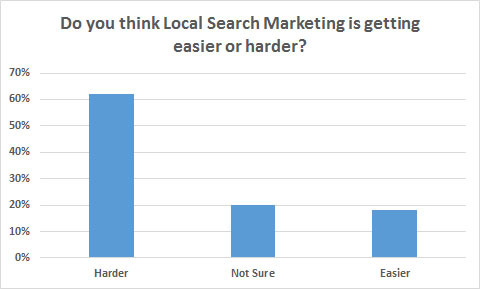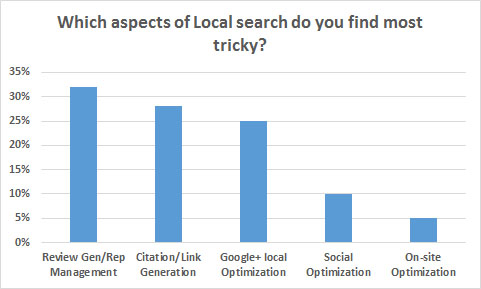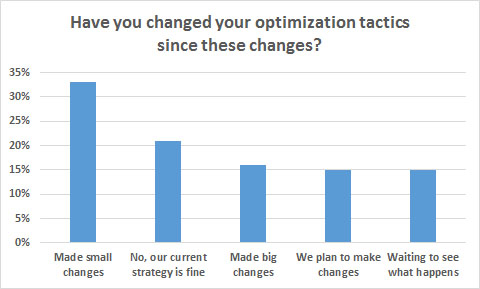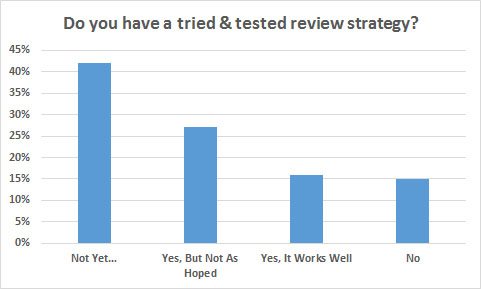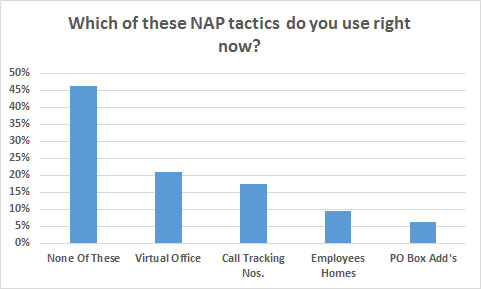62% Of Marketers Say Local Search Is Getting Harder
During the recent InsideLocal webinar series, I’ve had the chance to gather the opinions and feelings of the hundreds of search agencies, consultants, “in-bound” marketers and business owners who logged in to listen. We ran a number of on-the-spot surveys (or polls) during each webinar, which helped to complement the expert views provided by our […]
During the recent InsideLocal webinar series, I’ve had the chance to gather the opinions and feelings of the hundreds of search agencies, consultants, “in-bound” marketers and business owners who logged in to listen.
We ran a number of on-the-spot surveys (or polls) during each webinar, which helped to complement the expert views provided by our speakers. In these polls, we addressed a number of issues ranging from “Is SEO getting harder?” through to specifics of “Review Strategy” and “Optimization for Service Area Businesses.”
The following charts represent the results of these polls and provide some very interesting insights into what is happening among our peers in SEO-land!
Note: recordings for all recent InsideLocal webinars can be found here.
1. Is Local Search Marketing Getting Easier Or Harder?
Key Findings:
- 62% said that local search marketing is getting harder
- Only 18% said that local search marketing is getting easier
Analysis:
The majority of respondents believe that local search marketing is getting harder. Certainly local search is becoming more complex and more difficult to stay on top of. Regular product updates, algorithm changes, and increasing mobile search usage (to name just a few factors) mean we work in one of the most fluid industries around.
Yet, as Google closes the loop on various short-term, spammy SEO tactics, the strategy options available to local search marketeers are being simplified.
Rather than chasing Google and trying to trick your way to better visibility, smart SEOs listen to what Google says they want from a business or site, and they have created solid, reusable and future-proof strategies that they can apply to each customer they work with.
If you strip away the noise that surrounds local optimization, there are just a few pillars which make up a reliable, long term strategy:
- Verified and optimized Google+ Listing
- Correct, complete and well distributed business data (aka NAP, citations)
- Plentiful unique, relevant and engaging website content
- Positive reviews which are built up in a regular, steady manner
- Earned links from high quality and relevant websites
2. Which Aspects Of Local Search Do You Find The Trickiest?
Key Findings:
- 32% say that review generation and reputation management are hardest parts;
- 28% say that citation and link building are hardest;
- 25% say Google+ Local optimization is hardest
- Just 5% say that on-site optimization is hardest
Analysis:
The results of this poll won’t surprise many search marketeers. On-site optimization and content creation is a time-consuming process but one that we have greater control over — so you wouldn’t necessarily describe it as “tricky.”
Generating reviews, building citations and earning links are both time-consuming and difficult because we’re not in control of all the steps. There are plenty of pitfalls to contend with from clients who won’t implement a recommended review strategy through to directories which mess up our listings or refuse to reply to requests to update/merge listings. There are sore heads and dented desks up and down the country as people wrestle with these issues on an hourly basis.
It’s interesting to see that even with the great strides Google has made to make Google Places/Local easier to manage, 25% of people cited G+ optimization as the trickiest task. Google still has a long way to go to iron out the bugs in its system and make claiming, updating and managing listings a much easier task.
3. What Are The 2 Biggest Frustrations / Issues With SABs?
Local organisations that operate without an official business address are known as Service Area Businesses (SABs). The loose definition of an SAB is a businesse which provides their service at the customer’s home or business location; examples of SABs are plumbers, gardeners, cleaners, movers and exterminators. In local search optimization, SABs face more challenges to gain visibility in SERPs because of this lack of a physical address.
In this poll, we wanted to calibrate which optimization tasks/actions present the greatest challenges.
Key Findings:
- 26% of SABs say that dealing with reviews is the biggest issue / frustration
- 22% of SABs say that optimizing site content is the biggest issue / frustration
Analysis:
Again, reviews come out as the task which SEOs find most frustrating.
Interestingly, 22% said that creating good site content posed the biggest issue. It’s often difficult to get local business owners to actively and regularly create new content for their site. They may grasp the benefits content brings but are either too time strapped or just plain “stumped” about what to write. There is also the issue of how to create decent, unique content to populate multiple “product+location” landing pages which, in reality, have little differentiation.
In our “Optimization for SABs” webinar, Matthew Hunt gave a smart hint for how he works with some clients. Matt and his team research the most common questions relating to a product or service. Then they anonymously post these questions on the client’s site and get the client to answer them. It’s a smart idea that relieves the burden of producing content from the business owner and helps them communicate their knowledge in a helpful way.
4. Are Recent Changes In Google’s Display Permanent Or Temporary?
In October, Google pushed out some changes which saw a switch back to “7 pack” results in main search. This led leading local search commentators to state that a switch back to “pure” local results from the previously familiar “blended” results had taken place.
Key Findings:
- 57% believe that recent changes to Google+ local are merely temporary
- Just 22% think the changes are permanent
- 21% have no idea!
Analysis:
Because Google has a history of making frequent changes to its local search display, many local SEOs are left with the feeling that nothing is permanent in the world of Google — and from this, we can surmise that most SEOs consider them to be simply testing various formats before arriving at a preferred setup.
5. Have Your Clients Lost Rankings In Recent Google Algo Changes?
This question also relates to the changes Google pushed out in October.
Key Findings:
- 48% of SEOs have seen no, or very little change in their local search rankings
- 25% say they have seen gains in rankings
- 26% say they have seen losses in rankings
Analysis:
The results of the recent changes in Google’s local display algo is inconclusive. Most SEOs have seen very little change in their rankings, while an equal number have seen gains as have seen losses.
6. Have Your Tactics Changed As A Result Of These Changes?
Key Findings:
- 49% say they have made changes to their strategy
- 15% plan to make changes
- 21% are confident that their current strategy is correct and see no need to change
Analysis:
Most SEOs have made small tweaks to their strategies as opposed to wholesale changes. This result is not surprising considering that most respondents reported little or no change to their rankings after these changes.
Those businesses/SEOs who have a robust, long-term strategy will be less affected by such changes. They will not feel the shocks as much as the “short-term” SEOers, meaning they can stay focused on executing the strategy they have laid out and will be productive because of this.
7. Do You Have An Effective Review Strategy?
Given that Reviews/Review Generation were selected as the most tricky parts of local search marketing (see charts 2 & 3 above) we focused on this in two of our webinars and asked attendees to answer specific questions about their Review Strategy.
Key Findings:
- 42% of respondents do not have a tried and tested review strategy
- 27% do have a review strategy but admit it is not working as well as they would like
- Just 16% have a successful review strategy
Analysis:
It’s clear that not many SEOs have a tried and tested review strategy in place. It is little wonder then that local SEOs are finding this the hardest task to manage and make a success of.
The power of a successful, working review strategy goes well beyond the SEO benefits of visibility and conversion. If done correctly, the act of asking for reviews, tracking the results and feeding these back to the “agents in the field” can instill greater pride and satisfaction in the workforce.
Thomas Ballantyne from Bullwark Pest Control shared some interesting data about the relationship between Review Count and Customer Referrals. In his business, the three locations which have generated the highest number of online reviews also have the highest referral rate for new customers. He believes that by asking customers for a review, you’re involving them more deeply in your business; they make a commitment to you by providing that review and are more likely to back that up by referring their friends, neighbors and colleagues to you.
8. Which NAP Tactics Are You Currently Using?
From our SAB webinar, we wanted to understand what tactics search marketers we’re using to help their customers get around the “private address” issues and/or rank in areas beyond their immediate suburb or town.
Key Findings:
- A majority 46% do not use any of the above NAP tactics
- 37% use some sort of phony address — virtual office, employee’s home or a P.O. Box
- 21% do use virtual offices
- 17% use call tracking numbers
Analysis:
It’s good to see that a large number of search marketeers are not engaging in potentially damaging tactics to generate phony addresses.
Using a virtual office address is not necessarily a wrong or damaging tactic, and for some businesses it’s essential. However, Google gets smarter every day and they’re closing the loop on these types of locations, which means the benefits will dry up over time. P.O. boxes and employees’ homes directly contravene Google’s Terms & Conditions and should only be used if an employee actually sees customers at his home (although this will be hard to convince Google of).
On the issue of Call tracking numbers. If used correctly, these are very powerful. They should never be used on your G+ listing or on your citations — these should be a genuine and consistent local number. The correct place to use call tracking is on your own website, where you can load the numbers using javascript so that they don’t get crawled by Google.
Smart marketers set up multiple tracking numbers and assign them to different channels — so, if a customer clicks through from Google or Yelp or Facebook, and then makes a call, that call/lead can be attributed back to the specific site or channel the customer originated on.
And Finally….
A big BIG “thank you” to all the expert speakers and attendees of the InsideLocal webinar series for sharing their knowledge and tips and for participating in the polls. And, an especially big ‘thank you’ to Linda Buquet and the team at Local Search Forum for their hard work and dedication in supporting the InsideLocal webinar series.
Opinions expressed in this article are those of the guest author and not necessarily Search Engine Land. Staff authors are listed here.
Related stories
New on Search Engine Land
